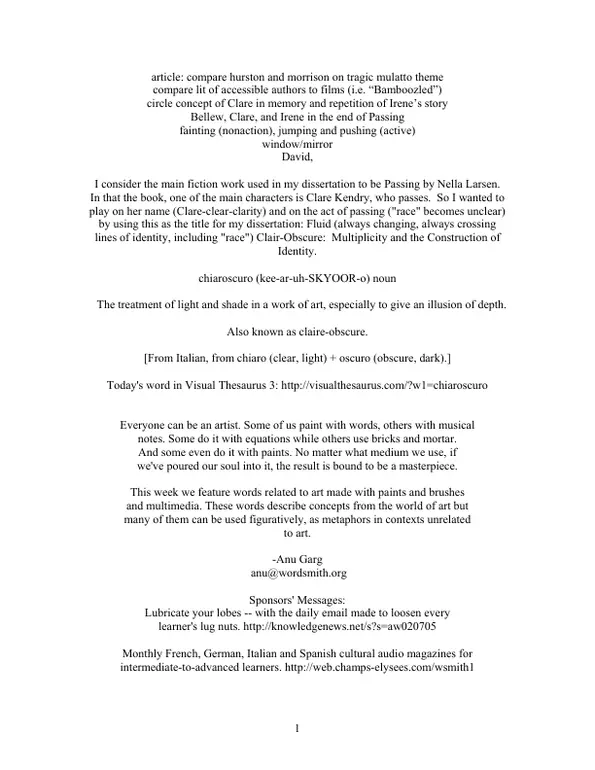This work will reflect on the mutability of meaning in the female mulatto body as well as on the mutability of perception by acknowledging the erroneous nature of race and its concrete results, by examining the valorization and undermining of racial essentialism and heterogeneity, and by revealing passing as bound by the social and legal restraints related to the physical body even as it interrogates racial classifications. Specifically, this study will explore how some nineteenth century, modern, and postmodern American narratives containing mulattoes and passing personas produce a resolution reiterating the structure of race or new subjectivities within or possibly without the color line. Through this exploration, the war between the homogenous Self and the different Other will play out. In an effort to unite a divided personality, the Other will counter attempts by the Self to maintain essentialism. The success lies not in the final outcome but in recognizing the subversive acts of the Other and the irrational tactics of the Self as continuously revealing the subjects as always already married and as surpassing mere essentialism into the multitudinous, heterogeneous One. Still, this work realizes that essentialism has a place in heterogeneity, even if essentialism is a logical error. Duality and conflict are inherent in heterogeneity, or the multitudinous One. The key is not to eradicate, in an essentialist manner, one and not the other, but to live in a state of awareness, respecting and accepting those who knowingly choose to construct identities within or without the color line.
Inhaltsverzeichnis (Table of Contents)
- Introduction Reading Meaning in the Mixed Body
- Chapter One Assimilating into What?: Stereotypes, Appearances, and Behavior
- Chapter Two Eliminating the Tragic: Intersections of Christianity, Racial Uplift, and True Womanhood
- Chapter Three Passing as Subversion and Reification
- Chapter Four The Journey Home: Replacing Tragedy with Authority
- Chapter Five Looking Within and Beyond Race with Irene, Clare, and Angela
- Chapter Six From the Passing Mulatto to the Biracial Character: Race, Class, Gender, and Family
Zielsetzung und Themenschwerpunkte (Objectives and Key Themes)
This work examines the shifting understanding of race and identity in American literature, specifically focusing on the female mulatto figure and the phenomenon of passing. It explores the limitations of traditional racial classifications and the complex interplay of race, class, and gender in shaping individual and collective identities.
- The Mutability of Meaning in the Female Mulatto Body
- The Erroneous Nature of Race and its Concrete Results
- The Valorization and Undermining of Racial Essentialism and Heterogeneity
- Passing as a Challenge to Established Racial Categories
- The Intersections of Race, Class, and Gender in Shaping Identity
Zusammenfassung der Kapitel (Chapter Summaries)
- Chapter One analyzes the illogical concept of race and its reliance on stereotypes and the tragic mulatto theme. It explores assimilation tactics employed by both abolitionists and black-authored texts, highlighting the conflicted desire for reunion with the dominant white society.
- Chapter Two examines the intersections of Christianity, racial uplift, and the cult of true womanhood in the works of Stowe, Kelley, and Harper. These texts show mulatto characters upholding Christian values and the tenets of true womanhood, but also reinforcing the value of whiteness and domesticity.
- Chapter Three delves into the complex phenomenon of passing, focusing on its complications and nuances in the tragic mulatto theme. Works by Harris, Chesnutt, and Johnson reveal how the passing character transitions from mere stereotype to psychological awareness, challenging the rigid boundaries of racial categorization.
- Chapter Four explores the tragic mulatto theme and passing figures in Harlem Renaissance literature. It analyzes the works of Hughes, Toomer, White, Fauset, and Larsen, showcasing the mulattoes' struggle with patterns of twoness and their increasing psychological awareness in a modern social context.
- Chapter Five examines new approaches to achieving existence in the One, focusing on the passing characters in Passing and Plum Bun. These characters engage the dynamics of the gaze and fantasy, empowering themselves to look within and beyond race and enter a different state of consciousness.
Schlüsselwörter (Keywords)
The dissertation focuses on key terms and concepts such as the tragic mulatto, passing, racial essentialism, heterogeneity, hybridity, the color line, assimilation, racial uplift, the cult of true womanhood, and the Harlem Renaissance. It explores these themes through the lens of American literary narratives and cultural studies, examining the complex interplay of race, class, gender, and family in shaping individual and collective identities.
- Citar trabajo
- Dr. Tamara Hollins (Autor), 2003, Turning Dreams to Chaos: Multiplicity and the Construction of Identity, Múnich, GRIN Verlag, https://www.grin.com/document/74993



